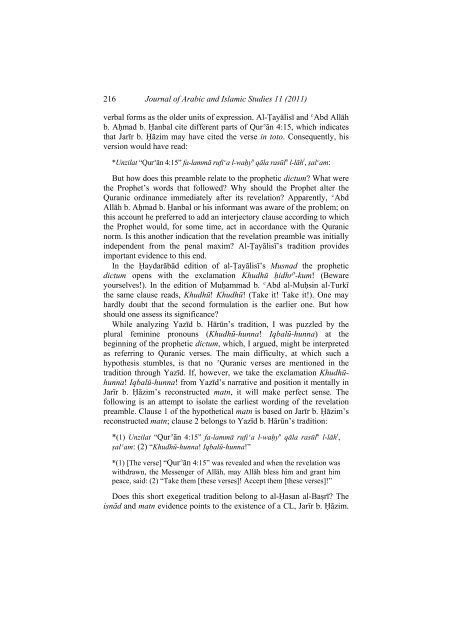JOURNAL OF ARABIC AND ISLAMIC STUDIES
JOURNAL OF ARABIC AND ISLAMIC STUDIES
JOURNAL OF ARABIC AND ISLAMIC STUDIES
Create successful ePaper yourself
Turn your PDF publications into a flip-book with our unique Google optimized e-Paper software.
216<br />
Journal of Arabic and Islamic Studies 11 (2011)<br />
verbal forms as the older units of expression. Al-Ṭayālisī and ʿAbd Allāh<br />
b. Aḥmad b. Ḥanbal cite different parts of Qurʾān 4:15, which indicates<br />
that Jarīr b. Ḥāzim may have cited the verse in toto. Consequently, his<br />
version would have read:<br />
*Unzilat “Qurʾān 4:15” fa-lammā rufiʿa l-waḥy u qāla rasūl u l-lāh i , ṣalʿam:<br />
But how does this preamble relate to the prophetic dictum? What were<br />
the Prophet’s words that followed? Why should the Prophet alter the<br />
Quranic ordinance immediately after its revelation? Apparently, ʿAbd<br />
Allāh b. Aḥmad b. Ḥanbal or his informant was aware of the problem; on<br />
this account he preferred to add an interjectory clause according to which<br />
the Prophet would, for some time, act in accordance with the Quranic<br />
norm. Is this another indication that the revelation preamble was initially<br />
independent from the penal maxim? Al-Ṭayālisī’s tradition provides<br />
important evidence to this end.<br />
In the Ḥaydarābād edition of al-Ṭayālisī’s Musnad the prophetic<br />
dictum opens with the exclamation Khudhū ḥidhr a -kum! (Beware<br />
yourselves!). In the edition of Muḥammad b. ʿAbd al-Muḥsin al-Turkī<br />
the same clause reads, Khudhū! Khudhū! (Take it! Take it!). One may<br />
hardly doubt that the second formulation is the earlier one. But how<br />
should one assess its significance?<br />
While analyzing Yazīd b. Hārūn’s tradition, I was puzzled by the<br />
plural feminine pronouns (Khudhū-hunna! Iqbalū-hunna) at the<br />
beginning of the prophetic dictum, which, I argued, might be interpreted<br />
as referring to Quranic verses. The main difficulty, at which such a<br />
hypothesis stumbles, is that no ʾQuranic verses are mentioned in the<br />
tradition through Yazīd. If, however, we take the exclamation Khudhūhunna!<br />
Iqbalū-hunna! from Yazīd’s narrative and position it mentally in<br />
Jarīr b. Ḥāzim’s reconstructed matn, it will make perfect sense. The<br />
following is an attempt to isolate the earliest wording of the revelation<br />
preamble. Clause 1 of the hypothetical matn is based on Jarīr b. Ḥāzim’s<br />
reconstructed matn; clause 2 belongs to Yazīd b. Hārūn’s tradition:<br />
*(1) Unzilat “Qurʾān 4:15” fa-lammā rufiʿa l-waḥy u qāla rasūl u l-lāh i ,<br />
ṣalʿam: (2) “Khudhū-hunna! Iqbalū-hunna!”<br />
*(1) [The verse] “Qurʾān 4:15” was revealed and when the revelation was<br />
withdrawn, the Messenger of Allāh, may Allāh bless him and grant him<br />
peace, said: (2) “Take them [these verses]! Accept them [these verses]!”<br />
Does this short exegetical tradition belong to al-Ḥasan al-Baṣrī? The<br />
isnād and matn evidence points to the existence of a CL, Jarīr b. Ḥāzim.

















